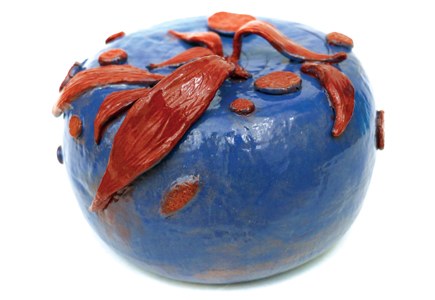
Lilly, textured adjective sculpture
Considering Clay
Clay is a primary sculpting material for artists, which is why I wanted students in my 3D class to experience hand-building techniques with clay to create sculptural forms. Instead of giving them a theme or solid plan of action, students were asked to select texture adjectives from lists at sites such as Owlcation (see Web Links). Keeping the medium in mind, students sketched out possible solutions for sculptural forms they were interested in creating.
Researching Contemporary Artists
After sketching their ideas, students paired up with a partner and researched contemporary ceramicists and sculptors such as Alberto Bustos, Hitomi Hosono, and Collin Lynch.
After viewing multiple works, the partners selected one piece from each artist to discuss as a class. The works were pulled up on a large display screen and the pairs took turns presenting their thoughts on adjectives that could be used to describe the forms and how those forms speak to other aspects of feeling or emotion through the textures/finishes shown.
Making Visual Connections
Participating in the adjective activity after students had already started working through some of their own ideas helped students use textural adjectives as a springboard for their designs and make visual connections between that process and contemporary artists who employ highly textured ceramic techniques in their work. This also helped students who were struggling with ideas and needed more visual cues to guide them to design options.
Combining Techniques
Next, demonstrations of hand-building techniques that included slabs, coils, molds, and armatures were done to help inform the works students wanted to create. In some cases, students even used a combination of wheel-thrown and hand-building to complete their works. The biggest keys I wanted students to keep in mind was to: (1) think about keeping their clay forms hollow; (2) be concerned with how their adjective was taking visual form in their work; and (3) complete it with a finish that helped enhance the work as a whole.
Results
The results were exciting. Students were engaged in creating work from abstracted concepts like language, starting with a word and creating a piece based on the visual connections made with that textural adjective. In addition to being able to demonstrate a variety of ceramic and sculptural I gave students the room they needed to explore as artists in their own right. techniques for students to apply in their work, I was able to expose students to dynamic contemporary artists who use clay as their medium to achieve a diverse array of results.
Most importantly, I gave students the room they needed to explore as artists in their own right and a pathway to be inspired from language and words to visuals. These connections are so important for our students to see and use as they continue to explore their own vision.

Lauren, textured adjective sculpture
Objectives
Students will:
- select a series of adjectives and create sketches to represent them visually.
- select one sketch to transform into a ceramic sculpture using a variety of hand-building techniques.
- select and apply glazes to the ceramic form for a finished result.
Janine Campbell is an art teacher at Byron Center West Middle School in Bryon Center, Michigan. janinecampbell@yahoo.com
NATIONAL STANDARD
Creating: Conceiving and developing new artistic ideas and work.
WEB LINKS
www.bcwmsart.weebly.com
www.essaraiceramics.com
www.owlcation.com/humanities/Describing-Texture-400-words-to-describe-texture
View this article in the digital edition.



